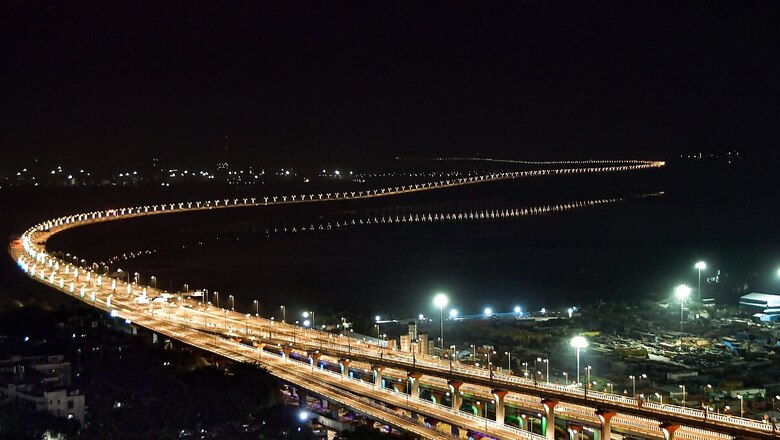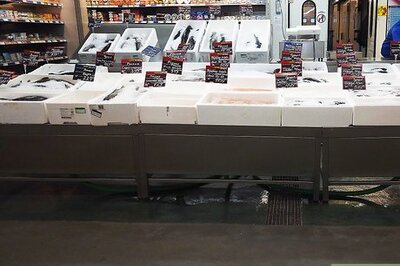
views
The Atal Setu may be the latest big-ticket infrastructure project to be opened to the public in Mumbai, but it is not the only one undertaken by the Maharashtra government. Ahead of the Lok Sabha elections, a number of other transforming projects are lined up with an aim to improve connectivity and reduce traffic congestion in India’s economic capital.
While the response to the Atal Setu, or the Mumbai Trans Harbour Link (MTHL), has been favourable, more such projects will focus on connecting satellite cities in the Mumbai Metropolitan Region (MMR).
Underground tunnel for Navi Mumbai commuters on MTHL
The MTHL is India’s longest sea bridge, which connects South Mumbai and Navi Mumbai, and has earned a revenue of Rs 14 crore in just a month. Travel time between these two destinations has been reduced to 20 to 22 minutes, while there is now enhanced connectivity to the Mumbai-Pune expressway. While the toll amount may be heavy at Rs 250, it is compensated in fuel and time.
Now, to save more travel time for commuters, who are using the Atal Setu from Navi Mumbai, the state government is planning an underground tunnel that will directly take them to Nariman Point.
This project, which is estimated to cost at least Rs 8,700 crore, will come up between Orange Gate and Marine Drive. It will be a 9.2-km tunnel connecting the Eastern Freeway and Marine Drive, which will help decongest traffic in this area. In peak hours, it takes 30 to 35 minutes to reach from Orange Gate to Marine Drive, but the tunnel will reduce this time by 10 to 15 minutes.
Coastal Road to cut congestion, travel time by 70%
It may have been plagued by a number of controversies and delays, but the Mumbai Coastal Road will help reduce congestion and travel time by 70%. The state government wants to partially open the project before the model code of conduct is implemented. Prime Minister Narendra Modi was to visit Mumbai on February 19 to inaugurate the first phase of the project, but this was cancelled.
The first phase between Nariman Point and Worli covers a distance of 11 km and authorities are confident that this will help reduce congestion in South Mumbai. The tunnel road will further connect to the Bandra-Worli Sea Link.
“The Mumbai Coastal Road project (south) is set to transform travel in the city, cutting congestion and travel time by 70%, while boosting average speeds to 80 kmph. This toll-free, signal-free route promises reduced pollution and a positive impact on social, environmental and economic aspects. With strategic interchanges and future expansions, it’s a comprehensive solution for Mumbai’s growing population and traffic challenges,” BMC additional municipal commissioner Ashwini Bhide told News18.
Reducing the burden on local trains
The local trains are known to be the lifeline of Mumbai, but whether it is the western or the central line, both are overburdened. As for vehicular traffic, it takes a minimum of two hours to reach South Mumbai from both the ends of the central and western lines.
The Mumbai Metro Line 3, which is still under construction, is likely to begin operations in a phased manner. Also known as the Aqua Line, when fully completed, it will span 33.5 km covering 27 stations from Cuffe Parade to Aarey Colony.
This line is expected to become operational in three phases and, as per sources, the first phase is likely to start between Aarey to Bandra Kurla Complex (BKC) by the end of May. Then, the second phase from BKC to Worli will start followed by the third phase from Worli to Colaba by December. The authorities are working hard as this will be the first partially underground Metro line.
“I had stopped using my car as it is a waste of time and fuel to travel in peak hours in Mumbai. I had to travel to my office in the western suburbs and in the town area to meet clients. As of now, the local train is my saviour but the journey is not comfortable. There are air-conditioned local trains on the western and central lines, but I am unable to match their timings. If Metro Line 3 or the Thane-Wadala line becomes operational, it will not only reduce the burden on local trains but it will be a comfortable journey for commuters as well. Recently, I went to Nagpur for three days and used the Metro there; it is well-connected to the major areas of the city,” said Rohan Tillu, a corporate communications specialist, who travels from Thane to his office in the western suburbs daily.
There are other Metro lines like 2A, which will connect Dahisar (east) to DN Nagar, and Line 2B, an extension of Line 2A connecting DN Nagar in the west to Mandale on the east side. Metro Line 4 connects Wadala in Central Mumbai to Kasarvadavali of Thane while Line 4A connects Kasarvadavali to Gaimukh, which is at the far end of Thane.
There are 14 Metro lines that will be constructed to make travel easier and, ultimately, encourage them to not use their personal vehicles and, in turn, reduce traffic congestion. Some Metro lines will also connect satellite towns around Mumbai like Kalyan, Bhiwandi, Badlapur, Mira Road and Bhayander.
Twin tunnels in the wild
Recently, the Mumbai Metropolitan Region Development Authority (MMRDA) has got the nod from the National Wildlife Board for the upcoming Thane-Borivali twin tunnel. It will pass through the Sanjay Gandhi National Park, which is home to 18 reserved wildlife species, while cutting down travel time between Thane and Borivali to 20 minutes, from the current one hour.
The MMRDA will invest approximately Rs 16,000 crore in the project, while the work has been awarded to Hyderabad-based ‘Megha Engineering Infrastructure’. The authority will build 10.25-km twin tunnels, with a 1.1-km approach road.
“In our pursuit to reshape Mumbai and reboot MMR, the MMRDA has envisioned a transformative roadmap. We are planning to build a road network in the next five years, spanning 546 km, that will alleviate congestion while the forthcoming 337-km Metro network will empower MMR with seamless connectivity. With the inauguration of Atal Setu by PM Narendra Modi, we’ve witnessed cities bridged in just 22 minutes, a testament to our commitment. The upcoming New Town at MTHL landing site promises affordable housing and enhanced connectivity… Additionally, two tunnel projects will seamlessly integrate Mumbai’s heart and suburbs, heralding a future of signal-less connectivity…” said MMRDA metropolitan commissioner Dr Sanjay Mukherjee.
















Comments
0 comment